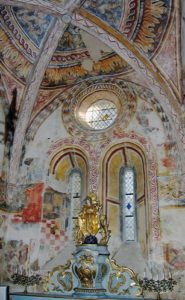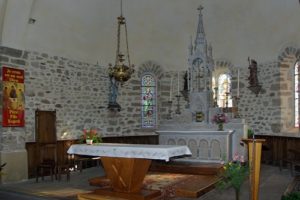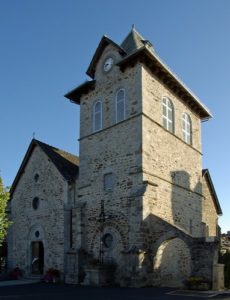Cassaniouze is a small village on the plateau at the southern end of the Cantal. At the entrance to the village is a sign for the 14thC bell tower. The church is a fairly simple building with a nave attached to the bell tower. This is all that is left of the original church which was demolished in 1905 as it was in a state of collapse. Some of the old stone was reused when the present church was rebuilt 1906-7.
Entry to the church is through the plain west door. Immediately to right is passageway into the small chapel beneath the bell tower which is all that remains of the original church building. Nothing had prepared us for what we saw. It is so beautiful and a mass of colour as walls and ceilings are covered with the remains of 13th, 14th, and 15thC frescoes.
Rather than religious pictures, these are abstract or geometric designs. The wall arches have a triangular design in reds, yellows and blacks. The sides of the windows have panels of yellow and red. Red scrolls form a border above the long narrow chancel windows. Above is a small round window which has a sheaves of wheat design around the window in yellows and reds, then circles with red lilies on a yellow background and finally a yellow circle with small red loopy patterns with red borders on circle.
There is a wide frieze half way up the wall with a black background and a scroll design in reds, yellows and whites. Below this is the remains of a yellow band with red diagonals.
The ceiling ribs are painted with red wavy lines along the sides and the ceiling vaults have a series of decorative circles with black, yellow and red designs. There are small carved heads at the base of the ceiling ribs, including a lovely one of an Atlantis Imperturbables (a head with two hands holding up the top).
A wooden altar rail separates the chancel which has a blue altar has a gilt and blue urn shaped host box with a lopsided cross on the door and gilt scrolls on the sides. Above is a gilt statue of Mary crowned with a tiara who is standing on a blue sphere with gilt stars and a serpent at her feet. On either side are painted statues of Joseph and one of Mary holding the baby Jesus.
The remains of two niches in the walls hold church treasures. That on the north wall has old crucifixes, Bibles and rosaries. The larger niche on the south wall has a 15thC processional cross with a crucifix and small bells as well as two small ostensoirs.
The main church is plain in comparison. It has a wide nave with transepts and rounded chancel apse. The walls are stone with a plastered ceiling which is slightly vaulted above the chancel. On the walls are wood carvings of the Stations of the Cross in very decorative wooden frames. The wooden pulpit has carvings of the four evangelists on the sides. The canopy above has a carved spire and a cross. There is a simple wooden mass alter with an elegant white stone high altar behind. This has pillars and round arches on the base with inset gilt decoration. Behind is a stepped retable with more gilt and an integral host box with huge decorative hinges. Four pillars enclose the crucifix and support a church spire with pinnacles.
The simple Romanesque chancel windows have images of Joan of Arc (north), Christ (centre) and St Roch (south). On the walls are statues of Joan of Arc, St Antoine de Padoue, St Roch and St Michael killing the dragon. Round the base of the chancel are wooden panels.
Both north and south transepts have altars. These have carved pillars on the base and a host box. The north altar has a statue of St Joseph with the young Jesus and a large painting of the baby Jesus being presented at the temple. There is a confessional on the west wall with a picture of the baptism of Christ above. The stained glass window has an image of Christ.
The south altar has a statue of Virgin and Child and a picture of the Assumption of the Virgin above. There is a confessional and a picture of the Virgin and Child presenting rosaries to St Dominic and Ste Catherine de Sienna above. The stained glass window is of the Virgin and child.
The font by the west door has a gilt host box above and on the wall is a large painting of John the Baptist baptising Jesus with a dove representing the Holy Spirit beaming down on him. On the other side is a memorial to the dead of World War One. Above is a painted wall carving of Christ
This is a fascinating church and an unexpected surprise. There is a certain amount of information (in French) in the church but even the Cassianouze website makes no mention of the bell tower chapel.










